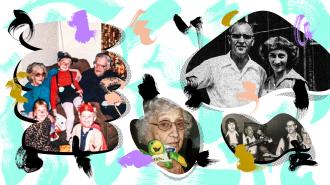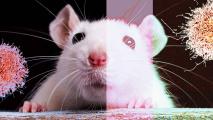When I think about longevity, I don’t think about science labs or supplements. I think about my paternal grandparents — my baba and pap-pap. As a latchkey kid growing up in Midland, Pennsylvania, in the ‘80s and early ‘90s, I spent many afternoons at their house, which was two doors down from ours.
My pap-pap was largely confined to a recliner in the living room, his mobility stolen by a series of strokes. I was told he was once a steelworker who played a mean upright bass in a Yugoslavian folk band. I passed by the large instrument every time I walked through their front door, but I never saw it out of its case. My baba, however, was seemingly always moving, and I was always underfoot, poking around her kitchen for cookies but settling for Corn Flakes I could dump sugar on. I followed her on walks to the local grocery store, hoping we’d stop by the town’s only restaurant for milkshakes. I’d fall asleep on her couch after “helping” solve the puzzles in the word search books she kept in a drawer next to it.
My parents divorced when I was 13, and my siblings and I moved away with my mom. I didn’t see my dad’s parents much after that, but when I was in my mid-20s, he took us to visit our baba in the nursing home where she was now living (our pap-pap had died years prior). She didn’t recognize me, and even after I told her my name, she just seemed confused, so we left soon after we arrived. It was the last time I saw her.
I’ve thought about my baba and pap-pap often as we put together this special issue on longevity. It’s hard to imagine something more world-changing than the ability to prevent death, or at least significantly delay it. But longevity researchers aren’t just on the cusp of extending the number of years people live. They’re also discovering ways to prevent and treat the physical ailments and neurodegenerative diseases that often come with age — conditions that strip away independence, diminish quality of life, and fill seniors’ final years with pain and confusion.
Some news outlets are taking advantage of this very real progress in longevity research by publishing exaggerated claims, while self-proclaimed experts are exploiting it by selling unproven anti-aging treatments. I’m proud to say we’ve compiled a remarkable collection of features, essays, and op-eds that separate scientific fact from fiction, while also exploring some of the philosophical and ethical questions surrounding the longevity movement. Biologist Matt Kaeberlein explains how new dementia treatments could be hiding in the diets of dogs. Journalist Namir Khaliq immerses himself in the immortality tribe at Vitalist Bay, the world’s largest longevity conference. Biomedical gerontologist Aubrey de Grey lays out how he thinks Joe Rogan could help spark a COVID-scale war on human aging — and much more.
This research excites me not only because it would mean less pain and suffering in the world for seniors. It excites me because it could mean more opportunities for connection. I never got to see my pap-pap walk without a cane, and my last adult memory of my baba centers on one sad afternoon in a nursing home. But future generations could have decades more to make happy memories with their grandparents or even their great-grandparents. That’s more time for drinking milkshakes, solving puzzles, and offering thanks for all the love and attention they showed you as a kid. That’s the promise of longevity: not just more years, but more moments that matter.
Click here to read the rest of the issue.
We’d love to hear from you! If you have a comment about this article or if you have a tip for a future Freethink story, please email us at [email protected].





















